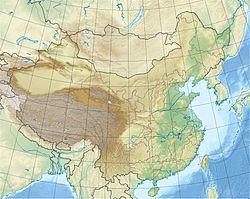南莊頭 | |
| Location | Hebei |
|---|---|
| Region | North China Plain |
| Coordinates | 39°07′00″N 115°39′00″E / 39.1167°N 115.65°E |
| History | |
| Founded | 12,600 BP |
| Abandoned | 11,300 BP |
| Periods | Neolithic China |
Nanzhuangtou (Chinese: 南庄头, Nánzhuāngtóu), dated to 12,600–11,300 cal BP[1] or 11,500–11,000 cal BP,[2] roughly 9,500–9,000 BC, or 10,700–9,500 BP,[3] roughly 8,700–7,500 BC, is an Initial Neolithic site[3] near Lake Baiyangdian in Xushui County, Hebei, China. The site was discovered under a peat bog.[4] Over 47 pieces of pottery were discovered at the site. Nanzhuangtou is also the earliest Neolithic site yet discovered in northern China. There is evidence that the people at Nanzhuangtou had domestic dogs 10,000 years ago.[5] Stone grinding slabs and rollers and bone artifacts were also discovered at the site. It is one of the earliest sites showing evidence of millet cultivation dating to 10,500 BP.[2] Pottery can also be dated to 10,200 BP.[1]
The site was discovered in 1986, when a cultural layer of unearthed animal bones, charcoal, and stone tools was discovered. The layer was 180 centimeters below the ground, which is covered with lake deposits such as thick black and gray silt clay. Three archeological excavations have been carried out so far by institutions such as the Department of Archaeology in Peking University, the Department of History in Hebei University, the Hebei Provincial Institute of Cultural Relics and other cultural institutions in the city and county level.
The Early Neolithic period (7,000 BC-5,000 BC) succeeds Nanzhuangtou, and is characterized by the rise of farming villages across the alluvial plains of China, as seen in the site of Peiligang.[3]
References
- ^ a b Kuzmin, Yaroslav V. "Chronology of the earliest pottery in East Asia: progress and pitfalls" Archived 2013-12-24 at the Wayback Machine ANTIQUITY-OXFORD- 80, no. 308 (2006): 362.
- ^ a b Xiaoyan Yang, Zhiwei Wan, Linda Perry, Houyuan Lu, Qiang Wang, Chaohong Zhao, Jun Li, Fei Xie, Jincheng Yu, Tianxing Cui, Tao Wang, Mingqi Li, and Quansheng Ge "Early millet use in northern China" Proceedings of the National Academy of Sciences 2012 vol 109 (10) pp. 3726–3730.
- ^ a b c Liu, Li (2005). The Chinese Neolithic: Trajectories to Early States. Cambridge University Press. p. 24. ISBN 9781139441704.
- ^ The Formation of Chinese Civilization: An Archaeological Perspective, p. 28.
- ^ Archaeology of Asia, pp. 124
- Beijing Union University Nanzhuangtou PDF 新石器时代考古:新石器时代早. 1993.http://www.doc88.com/p-3387746549380.html
Citations
Bibliography
- Allan, Sarah (ed), The Formation of Chinese Civilization: An Archaeological Perspective, ISBN 0-300-09382-9
- Liu, Li. The Chinese Neolithic: Trajectories to Early States, ISBN 0-521-81184-8
- Sagart, Laurent, Roger Blench and Alicia Sanchez-Mazas (eds), The Peopling of East Asia ISBN 0-415-32242-1
- Stark, Miriam T. (ed), Archaeology of Asia, ISBN 1-4051-0213-6
- Yang, Xiaoyan et al., Early millet use in northern China, Proceedings of the National Academy of Sciences of the United States of America, vol. 109 no. 10, 3726–3730, doi: 10.1073/pnas.1115430109
| Pre-Pottery Neolithic Pottery Neolithic | ||||||||||||
|---|---|---|---|---|---|---|---|---|---|---|---|---|
| BC 11000 | Europe | Egypt | Syria Levant | Anatolia | Khabur | Sinjar Mountains Assyria | Middle Tigris | Low Mesopotamia | Iran (Khuzistan) | Iran | Indus/ India | China |
| 10000 | Pre-Pottery Neolithic A Gesher[2] Mureybet (10,500 BC) | Early Pottery (18,000 BC)[3] | ||||||||||
| 9000 | Jericho Tell Abu Hureyra [4] | |||||||||||
| 8000 | Pre-Pottery Neolithic B Jericho Tell Aswad | Göbekli Tepe Çayönü Aşıklı Höyük | Initial Neolithic (Pottery) Nanzhuangtou (8500–8000 BC) | |||||||||
| 7000 | Egyptian Neolithic Nabta Playa (7500 BC) | Çatalhöyük (7500–5500) Hacilar (7000 BC) | Tell Sabi Abyad Bouqras | Jarmo | Ganj Dareh Chia Jani Ali Kosh | Mehrgarh I[2] | ||||||
| 6500 | Neolithic Europe Franchthi Sesklo [5] | Pre-Pottery Neolithic C ('Ain Ghazal) | Pottery Neolithic Tell Sabi Abyad Bouqras | Pottery Neolithic Jarmo | Chogha Bonut | Teppe Zagheh | Pottery Neolithic Peiligang (7000–5000 BC) | |||||
| 6000 | Pottery Neolithic Sesklo Dimini | Pottery Neolithic Yarmukian (Sha'ar HaGolan) | Pottery Neolithic Ubaid 0 (Tell el-'Oueili) | Pottery Neolithic Chogha Mish | Pottery Neolithic Sang-i Chakmak | Pottery Neolithic Lahuradewa Mehrgarh II Mehrgarh III | ||||||
| 5600 | Faiyum A | Amuq A | Halaf Halaf-Ubaid | Umm Dabaghiya | Samarra (6000–4800 BC) | Tepe Muhammad Djafar | Tepe Sialk | |||||
| 5200 | Linear Pottery culture (5500–4500 BC) | Amuq B | Hacilar Mersin 24–22 | Hassuna | Ubaid 1 (Eridu 19–15) Ubaid 2 (Hadji Muhammed) (Eridu 14–12) | Susiana A | Yarim Tepe Hajji Firuz Tepe | |||||
| 4800 | Pottery Neolithic Merimde [6] | Amuq C | Hacilar Mersin 22–20 | Hassuna Late Gawra 20 | Tepe Sabz | Kul Tepe Jolfa | ||||||
| 4500 | Amuq D | Gian Hasan Mersin 19–17 | Ubaid 3 | Ubaid 3 (Gawra) 19–18 | Ubaid 3 | Khazineh Susiana B | ||||||
3800 | Badarian Naqada | Ubaid 4 | ||||||||||
| Succeeded by: Historical Ancient Near East | ||||||||||||
- ^ Liverani, Mario (2013). The Ancient Near East: History, Society and Economy. Routledge. p. 13, Table 1.1 "Chronology of the Ancient Near East". ISBN 9781134750917.
- ^ a b Shukurov, Anvar; Sarson, Graeme R.; Gangal, Kavita (7 May 2014). "The Near-Eastern Roots of the Neolithic in South Asia". PLOS ONE. 9 (5): e95714. Bibcode:2014PLoSO...995714G. doi:10.1371/journal.pone.0095714. ISSN 1932-6203. PMC 4012948. PMID 24806472.
- ^ Bar-Yosef, Ofer; Arpin, Trina; Pan, Yan; Cohen, David; Goldberg, Paul; Zhang, Chi; Wu, Xiaohong (29 June 2012). "Early Pottery at 20,000 Years Ago in Xianrendong Cave, China". Science. 336 (6089): 1696–1700. Bibcode:2012Sci...336.1696W. doi:10.1126/science.1218643. ISSN 0036-8075. PMID 22745428.
- ^ Thorpe, I. J. (2003). The Origins of Agriculture in Europe. Routledge. p. 14. ISBN 9781134620104.
- ^ Price, T. Douglas (2000). Europe's First Farmers. Cambridge University Press. p. 3. ISBN 9780521665728.
- ^ Jr, William H. Stiebing; Helft, Susan N. (2017). Ancient Near Eastern History and Culture. Routledge. p. 25. ISBN 9781134880836.
